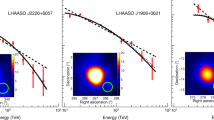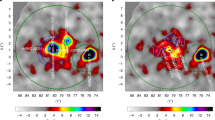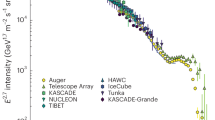Abstract
Supernovae are the likely origin of cosmic ray nuclei. This is because beams of cosmic rays seem to contain nuclei heavier than iron in astrophysically significant quantities.
This is a preview of subscription content, access via your institution
Access options
Subscribe to this journal
Receive 51 print issues and online access
$199.00 per year
only $3.90 per issue
Buy this article
- Purchase on Springer Link
- Instant access to full article PDF
Prices may be subject to local taxes which are calculated during checkout
Similar content being viewed by others
References
Earl, J. A., Phys. Rev. Lett., 6, 125 (1961).
Meyer, P., and Vogt, R., Phys. Rev. Lett., 6, 193 (1961).
Abraham, P. B., Brunstein, K. A., and Cline, T. L., Phys. Rev., 150, 1088 (1966).
DeShong, J. A., Hildebrand, R. H., and Meyer, P., Phys. Rev. Lett., 12, 3 (1964).
Hayakawa, S., and Okuda, H., Prog. Theoret. Phys., Kyoto, 28, 517 (1962).
Jones, F. C., J. Geophys. Res., 68, 4399 (1963).
Pollack, J. B., and Fazio, G. G., Phys. Rev., 131, 2684 (1963).
Ginzburg, V. L., and Syrovatskii, S. I., The Origin of Cosmic Rays (Pergamon Press, Ltd., London, 1964).
Brunstein, K. A., Phys. Rev., 137, B757 (1965).
Cline, T. L., Ludwig, G. H., and McDonald, F. B., Phys. Rev. Lett., 13, 286 (1964).
Brunstein, K. A., J. Geophys. Res., 72, 5510 (1967).
Walker, W. D., Phys. Rev., 90, 234 (1953).
Kearney, P. D., and Hazen, W. E., Phys. Rev., 138, B173 (1965).
Hayakawa, S., and Kitao, K., Prog. Theoret. Phys., Kyoto, 16, 139 (1956).
Burbidge, E. M., Burbidge, G. R., Fowler, W. A., and Hoyle, F., Rev. Mod. Phys., 29, 547 (1957).
Fowler, P. H., Adams, R. A., Cowen, V. G., and Kidd, J. M., Proc. Roy. Soc., A, 301, 39 (1967).
Volodichev, N. N., Grigorov, N. L., Nyesterov, V. E., Rapaport, I. D., Savenko, I. A., Skuridin, G. A., and Titenkov, A. F., Report to All-Union Conf. Cosmic Rays, Alma Ata (1966).
Brunstein, K. A., and Cline, T. L., Nature, 209, 1186 (1966).
Parker, E. N., J. Geophys. Res., 69, 1755 (1964).
Author information
Authors and Affiliations
Rights and permissions
About this article
Cite this article
BRUNSTEIN, K. Do Low-energy Cosmic-ray Electrons indicate Very Heavy Primaries?. Nature 218, 649–652 (1968). https://doi.org/10.1038/218649a0
Received:
Issue Date:
DOI: https://doi.org/10.1038/218649a0
Comments
By submitting a comment you agree to abide by our Terms and Community Guidelines. If you find something abusive or that does not comply with our terms or guidelines please flag it as inappropriate.



